
Original Link: https://www.anandtech.com/show/2289
The Enermax Liberty - Getting long in the tooth, but still worth a look
by Christoph Katzer on July 30, 2007 1:40 AM EST- Posted in
- Cases/Cooling/PSUs
Intro
Today we will be looking at the Enermax Liberty 500W power supply. Liberty? But that PSU is two years old! Yes, as a matter of fact it is, but since its release a few years ago it has served the community well, providing stable power and low failure rates. We thought it would be worthwhile to take a look at it and see how it compares to some of the latest and greatest PSUs we've been reviewing. It's still a very stable offering, and users running such a power supply will hopefully be able to determine whether or not they need to consider upgrading anytime soon.

Enermax has been in the power supply (and case) market for ages, and anyone who has taken the time to build and/or mod a PC in the past decade should already be familiar with the Enermax name. When they were founded in 1990, Enermax was one of the first companies to begin selling retail power supplies to the market, helping to bring us to where we are today. Over the past few years we've seen a tremendous growth of Enermax products, particularly when it comes to introducing new technology and being the first to market with new standards. Enermax has built up a successful team over the years with branch offices and warehouses around the world. Their headquarters are located in Taoyuan, Taiwan.

The Liberty was designed with cable management as one of the features, which continues to provide good flexibility two years after purchase. The discussions around the web about voltage drops caused by the modular cable design and the extra resistance that can create do not seem to be a problem for Enermax - they continue to design current models with modular cables. Enermax promotes the flexibility of cable management in their advertising, and it is said that you can run a decent high-end system with the smaller 400W Liberty and a few extra cables. For people who own a Liberty power supply that are looking to upgrade, they don't necessarily need to buy a new power supply. A few extra cables will be enough to run many newer systems as well. The 500W model comes with two 12V rails supporting 22A each - plenty strong for all but the most demanding configurations - and we will see later that their OCP is even a little higher than stated.
Package and Appearance

The power supply comes in a big box that is clearly designed for a retail store. You can find all the important information on the sides of the box. Enermax often likes to include a few extra goodies with their packaging, and that's the case with this unit. We found stickers and little Enermax magnets for your refrigerator, along with the expected power cord and screws. The component cables are stored in a high-quality bag and not simply attached to the PSU like we have seen with some other power supplies (i.e. Silverstone). In addition, you get three silicone caps that can be used to cover jacks that are not in use, helping to protect the jacks from dust and other debris.



The power supply itself comes in a shiny black coating. The 12cm fan is located in the middle of the lower side behind a shiny golden grille. The PSU uses a standard universal input and allows the usual 100-240VAC. The back of the casing that will be accessible when the unit is installed into a PC has hex-shaped holes all over to provide ample ventilation for the internal components.
Cables and Connectors


The cables come in a very nice bag that can be store unused parts. On the front of the PSU we find the jacks where the cables connect. There are six black and two red jacks. The black ones are reserved for the peripheral devices like optical drives and hard disks. The two red jacks are marked PCI-E and are keyed so that only the right cable can be connected (in case the color of the jacks didn't already clue you in).


You cannot plug a wrong cable into any of the jacks because of the design. The black sockets have one of the six holes closed, making it impossible to accidentally insert one of the red cable connections. Likewise, the red sockets have notched corners on the top-center hole to prevent the use of a black cable. Some modular PSUs assume that color coding of the cable connections is sufficient, but Enermax takes the extra step to ensure that no mistakes will be made on the part of end users.

In our new edition of power supply there's a 6-pin PEG cable attached that can easily be transformed into an 8-pin PCI-E 2.0 connector. The GPU side has the standard 6-pin connector with two additional cables for use with newer graphics cards, while the other side that connects to the PSU is split into two cables. The red plug connects to the standard PCI-E power jack and the second connector gets additional power form one of the black jacks. The additional 12V power will thus be drawn from the second 12V rail. This is a very clever move since the second 12V rail will typically not be loaded as much and still has power to deliver. Also, by using up one of the black connections, there is one less cable for connecting devices like HDDs, DVDs, fans, etc. so hopefully the total power use will remain within the rated spec.
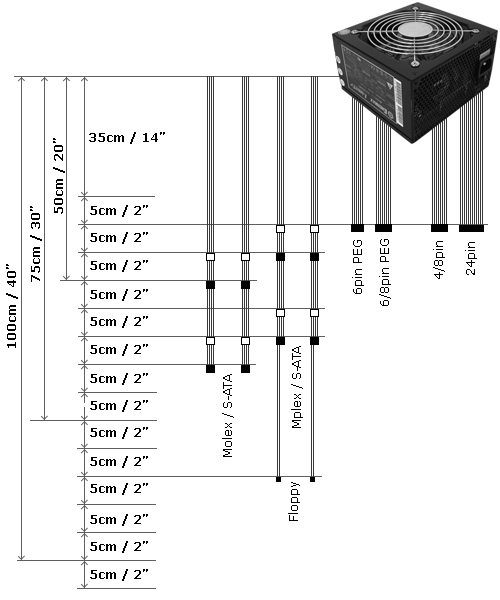
The cables are all long enough for average cases. The Molex connectors have a maximum length of 65cm and the SATA connectors reach 5cm less to 60cm. The difference on these cables is that the user will find SATA and Molex connectors together on each cable. Large full-tower cases or designs where the PSU is located on the bottom may have difficulty with the included cables, but for more typical cases the will work fine.
Inside - Primary Side


Looking down on the PCB there is nothing really special about it since it's a pretty typical design. Enermax placed the transient filter stage at the side of the PCB located next to the exiting air. Most of the filtering is done on a separate PCB with capacitors and coils. Two black and white colored cables pass the electricity through a fuse to the primary side.


Even though things may look a little disorganized, the components are doing their job. The rectifier bridge has its own little metal cooler since it will produce heat. It sits directly between the two big coils, making slight contact with the one on the right. On the left side we can find the PFC IC which as usual is on a separate PCB. We found a chip on this PCB manufactured by Texas Instruments called UCC3817AN, which combines PFC and PWM control into one chip. The PWM control stabilizes the DC outputs that are then passed to the components later. Combining these two chips is pretty typical for modern power supplies; if they're not combined the chip for the PWM control is usually located on the secondary side and will then have the protection functions for the rails integrated instead.
Secondary Side

The PCB that is home to the jacks used for the cable management looks very clean and appears to be of good quality. This is better than some other PSUs where we've seen a huge amount of solder all over the place. The modular cable design also eliminates a lot of clutter from the insides of the PSU, particularly when done in this fashion using a PCB. Even if the resistance were to increase slightly because of the modular cable connections, the improved airflow may help to offset this. Only the 24-pin/ATX-12V connections have wires in the interior of the PSU enclosure.


The secondary side looks good as well. The cables attached to the PCB have small shrinking hoses on the end for protection if they loosen from the board. On the left side we can see a small chip on the PCB that includes the protection features of this power supply. It is a chip called PS223 from the Taiwanese company Silicon Touch Technologies. This kind of chip is used often by Enermax and we have never encountered any problems with its functions as well. It combines support for Over Voltage Protection, Under Voltage Protection, Over Current Protection, and Over Temperature Protection.
The Fan


The Liberty has a large 12cm fan installed that blows air onto the components and heatsinks. It's manufactured by Globefan, another company whose parts are often used in Enermax products. It can run at a nice low speed of under 1000 RPM, but when necessary it can spin at over 2000 RPM.
Testing
As usual we are testing with our Chroma programmable loads to fully load each rail to a specific amount. This is important to get truly accurate results and not merely approximate values. The tests are conducted in two different temperature environments. One is normal room temperature of 25-26°C, while the second environment goes from room temperature and increases steadily up to 50°C. Especially during the higher temperatures we will see how good the power supplies are and what they're really made of. Components inside will perform much worse at higher temperatures, but we expect any good quality PSU to deal with such test conditions without failing.
Note: If you would like to know more about our testing methodology, equipment, and environment, please read our PSU testing overview.
3.3V DC Outputs
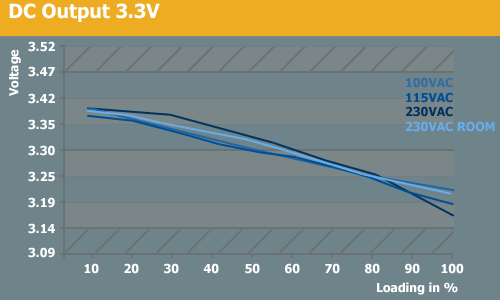
The 3.3V rail starts at 3.4V and drops steadily with increasing load like we usually experience. Heat doesn't seem to have a great impact on the components since the voltage drop looks similar with any input voltage at any temperature. The voltage held stable within regulations and have been only close to the limit with the highest load.
5V DC Outputs
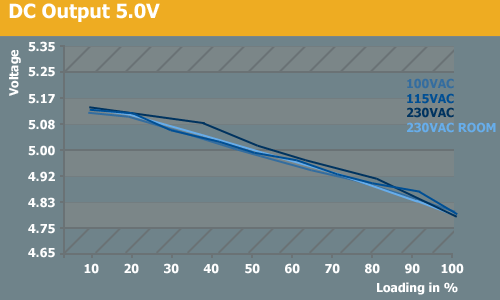
The 5V rail also starts at a high amount just like the 3.3V rail. The drop is almost constant and within specification.
Standby Efficiency
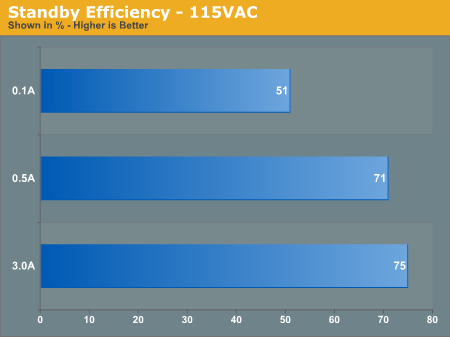
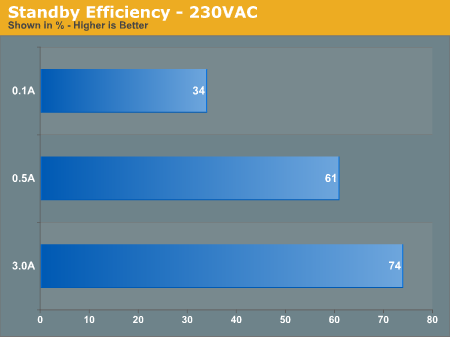
In standby mode which applies no load at all to the 5Vsb rail the Liberty uses 0.36-0.87W which is a much better result than what we've seen with other recent PSUs, for example at the previous review of the Gigabyte unit. We have to add that our standby mode is not directly comparable with reality because the mainboard always uses a little bit of power. Therefore we test the standby efficiency with different loads to see how efficient it is when a PC is switched off.
5Vsb DC Outputs
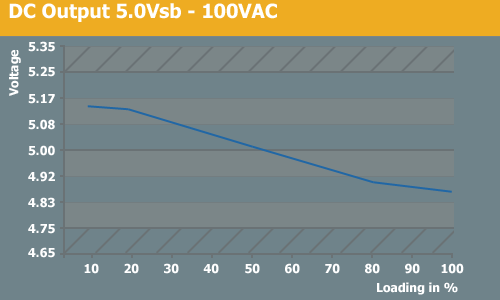
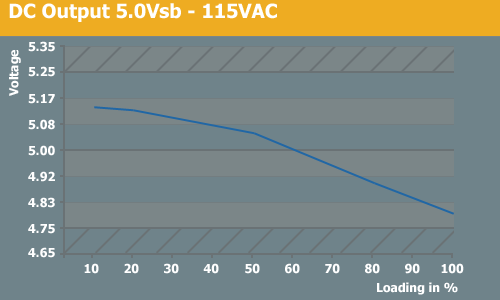
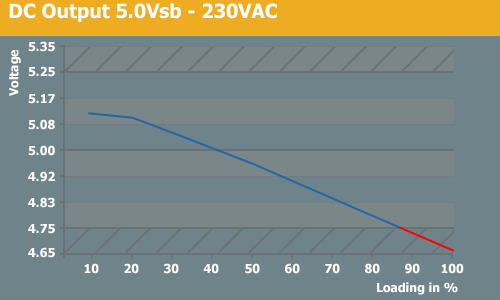
The Liberty has a very good standby efficiency as we can see from the above graphs. The voltage on the 5Vsb rail decreases steadily up to the highest load, which shouldn't be surprising to anyone anymore. It never exceeds specifications and therefore shouldn't cause any trouble. With a 230VAC input, it does fall below spec at the maximum load, but that's a pretty unlikely scenario and shouldn't cause any difficulties regardless.
12V DC Outputs
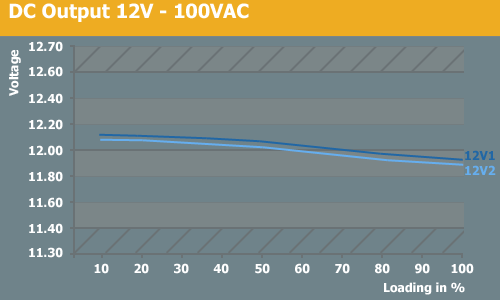
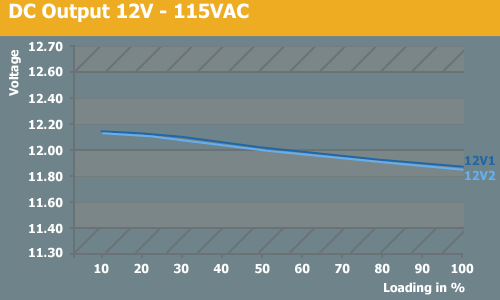
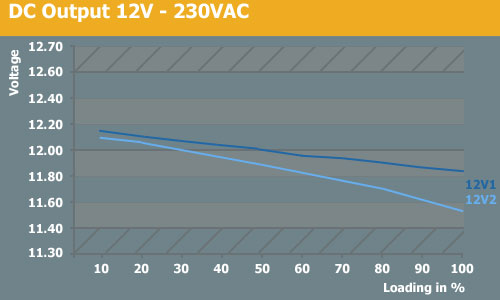
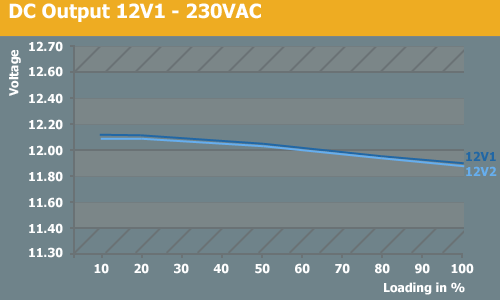
Room Temperature
The two 12V rails have been very stable. It didn't matter what temperature we were testing under; they always showed a very stable amount of within 0.2V of the ideal. It's only using 230VAC with higher temperatures of 40-50°C that we encountered anything worthy of note, as we see a sudden drop of the second rail which comes very close to the limit of 11.40V. Other than that specific case, it's also worth mention that the two 12V rails show almost the same results under all test conditions.
Efficiency
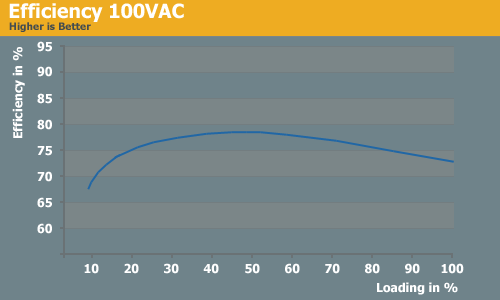
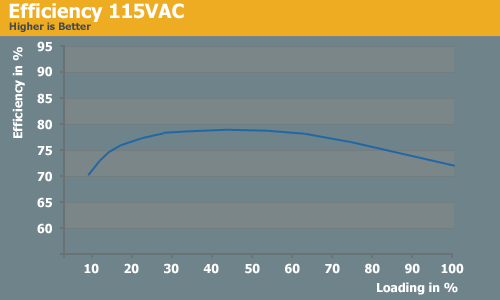
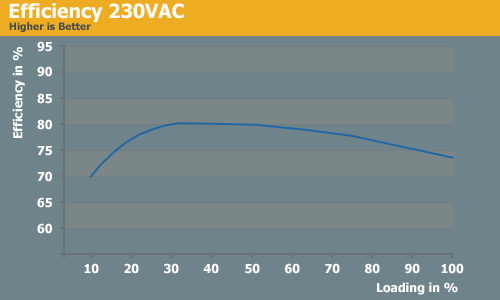
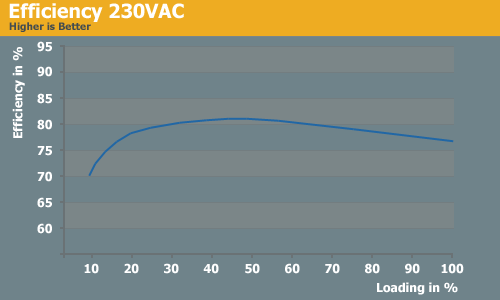
Room Temperature
Since the design of the Liberty is a few years old, we didn't expect incredible results. The efficiency is not very high compared to our most recent models, though we did measure an efficiency of 81% maximum which would have been good 2 years ago. For the most part, efficiency is in the 75-80% range with loads of 20% to 80%.
Power Factor Correction
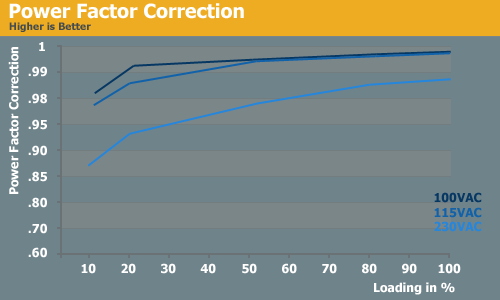
The PFC is very good at lower input voltages, while as usual we see worse results at 230VAC. Scores of .99 or higher are desirable, which the Liberty achieves on 115VAC. The 230VAC result is not unusual, and for a two year old model we won't complain too much. On higher-end PSUs we would like to see PFC break .99 at high loads even on 230VAC, but it's certainly not a bad result.
OCP Test
In the OCP test we use a function from the Chroma to see how much load each rail can take. The test puts on an additional 5A each second on the test rail until either the OCP kicks in or our Chroma will shuts down from overpowering.
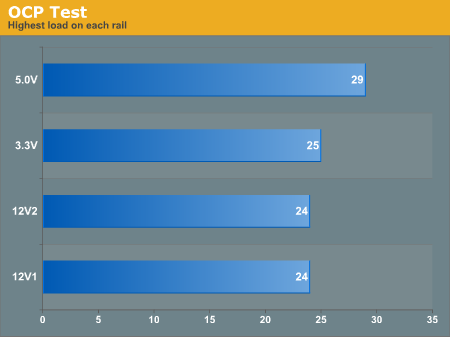
The Liberty performed well on the two 12V rails. The OCP was based at the usual amount of 24A. The 3.3V rail kicked in quite early; instead of the promised 28A we could only reach 25A and at the 5V rail we could only reach 29A instead of 30A. This is not a critical flaw, however, since the performance during testing was still very good and the 12V rails tend to be much more important than the 3.3V and 5V rails.
Temperatures
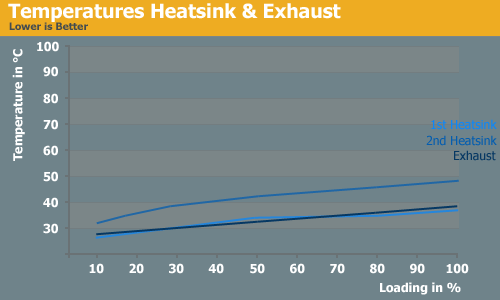
Room Temperature
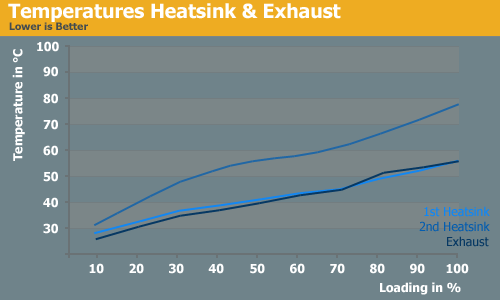
During the room temperature test the temps of the heatsinks is very low. At only 50°C on the secondary heatsink and 40°C on the primary it is definitely a good result. This has a lot to do with the fan, which begins increasing its rotational speed rapidly at loads above 50%. The heatsink design helps as well, as it leaves enough air so that components under it can be cooled as well.
Fan Speed
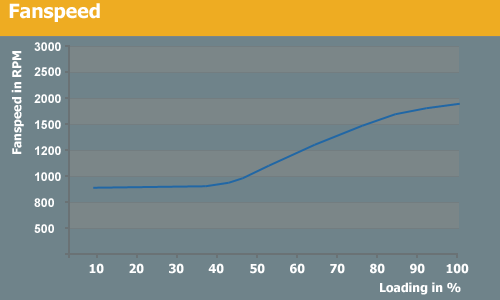
Room Temperature
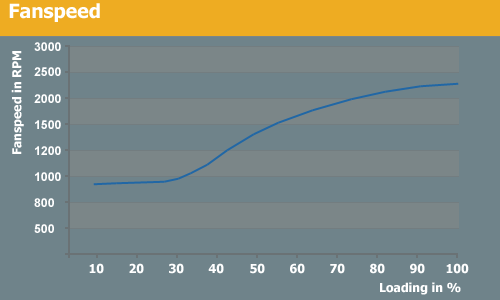
The curves of the two different ambient temperatures look similar; they only differ in maximum speed and the point at which the fan starts rotating faster. At room temperature fan speed starts ramping up at around 40% of load (around 250W). The curve then goes steadily up to its highest point of almost 2000 RPM. With higher ambient temperature the fan starts to spin faster at 30% load which is an approximate 190W. We measured a difference of about 250 RPM between the two ambient temperatures.
Acoustics
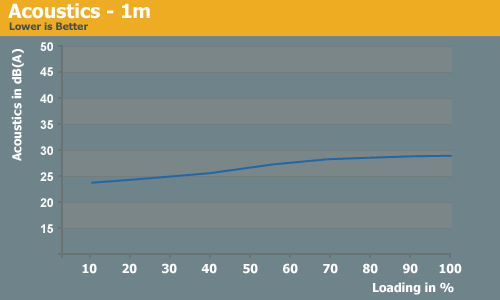
Room Temperature
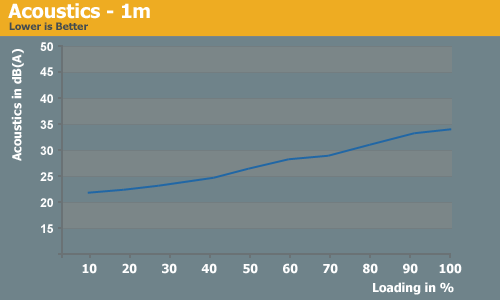
The two tests at room temperature and high temperature show clear differences in terms of noise levels. We measured 5dB(A) more under high temperatures when the fan was spinning 250 RPM faster. Enermax doesn't make a big deal about noise levels and has always stated that they prefer to have a well-performing power supply which can only be done by a fan that actually moves enough air through the housing. Enough air means that the fan needs to spin at higher speeds, and that means it will produce more noise. In comparison to some of the higher power units we've looked at the Liberty does quite well at being quiet; then again, it's only providing a maximum of 500W vs. 850W on some of the units we've tested.
Conclusion
There is frankly no need to buy this power supply today since there are better performing units in the market. With this review we mainly wanted to show what the Enermax Liberty is capable of since it was a popular unit for a long time - it was also one of Germany's top selling power supplies. From the quality perspective it is still a very fine product that is relatively quiet and very stable. The efficiency is behind the top units of today, but if you own already a Liberty there is no need for a change (unless perhaps you're looking at quad cores, overclocking, and HD 2900 XT CrossFire).
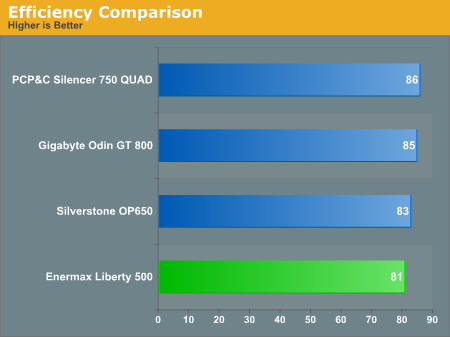
Comparing the efficiency of the Liberty 500W to the other power supplies we've tested, it ranks at the bottom of the chart right now. However, it's important to clarify that we take the highest efficiency reached during testing for this graph, regardless of load or input voltage used. This is how most manufacturers rate their PSUs, but for a more realistic look at efficiency you should read the individual PSU reviews. At 81%, the Enermax still does quite well, relative to many inexpensive units. It doesn't reach 85% or higher efficiency, but we don't really expect that from older models.
One of the great things about the Liberty - particularly for anyone that already owns one - is that Enermax has provided a reasonable upgrade path by creating new cables. Purchase those separately, and you can be PCI-E 2.0 compliant. With the two 6-pin PEG connectors you already have a decent amount of support for high-end systems, and the upgraded inclusions take that a step further. In our version we had the new 6/8-pin PEG cables, which will be the case for all packages purchased this year.
All the DC outputs have been stable within the specified area and only came close to the lower limit during high performing tests combined with high temperatures. We have been surprised about the very stable 12V rails which have been generally within 0.2V of the ideal voltage. From the acoustic point the Enermax Liberty is surely not silent since you can clearly hear it at medium to high loads. However, as our graphs show it is well cooled inside and this protects the PSU from overheating.
Today, the Enermax Liberty has an average price of around $110 USD or 84 EUR. At a cost of $110 it starts to encroach on the realm of modern high-end power supplies, which in some cases are newer and slightly better in terms of performance and efficiency. Newegg currently has a $10 mail-in-rebate, but even at a price of $100 we would recommend looking around at some of the latest offerings from competitors. The Liberty 500W isn't a bad PSU by any means, but neither is it really class-leading in any area.







